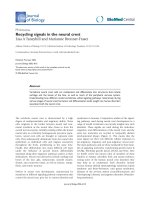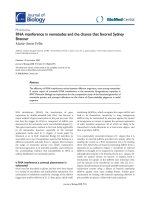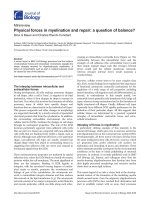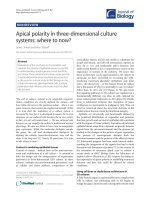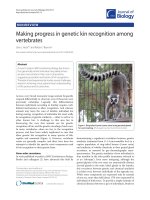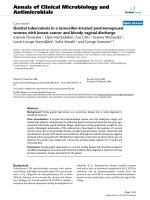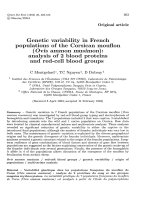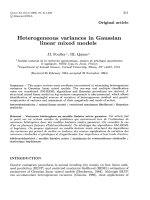Báo cáo sinh học: " Individual increase in inbreeding allows estimating effective sizes from pedigrees" pps
Bạn đang xem bản rút gọn của tài liệu. Xem và tải ngay bản đầy đủ của tài liệu tại đây (539.27 KB, 20 trang )
Original article
Individual increase in inbreeding allows
estimating effective sizes from pedigrees
Juan Pablo GUTIE
´
RREZ
1
*
, Isabel CERVANTES
1
, Antonio MOLINA
2
,
Mercedes V
ALERA
3
,Fe´lix GOYACHE
4
1
Departamento de Produccio´n Animal, Facultad de Veterinaria, Avda. Puerta de Hierro s/n,
28040 Madrid, Spain
2
Departamento de Gene´tica, Universidad de Co´ rdoba, Ctra. Madrid-Ca´diz, km 396
a
,
14071 Co´rdoba, Spain
3
Departamento de Ciencias Agro-Forestales, EUITA, Universidad de Sevilla, Ctra. Utrera km 1,
41013 Sevilla, Spain
4
SERIDA-Somio´ , C/ Camino de los Claveles 604, 33203 Gijo´ n (Asturias), Spain
(Received 14 May 2007; accepted 9 January 2008)
Abstract – We present here a simple approach to obtain reliable estimates of the effective
population size in real world populations via the computation of the increase in
inbreeding for each individual (delta F
i
) in a given population. The values of delta F
i
are
computed as t-root of 1 À (1 À F
i
) where F
i
is the inbreeding coefficient and t is the
equivalent complete generations for each individual. The values of delta F computed for
a pre-defined reference subset can be averaged and used to estimate effective size. A
standard error of this estimate of N
e
can be further computed from the standard deviation
of the individual increase in inbreeding. The methodology is demonstrated by applying it
to several simulated examples and to a real pedigree in which other methodologies fail
when considering reference subpopulations. The main characteristics of the approach and
its possible use are discussed both for predictive purposes and for analyzing genealogies.
effective size / increase in inbreeding / overlapped generation / genetic contribution
1. INTRODUCTION
The effective population size (N
e
), defined as ‘the size of an idealized popu-
lation which would give rise to the rate of inbreeding, or the rate of change in
variance of gene frequencies observed in the population under consideration’
[27], is a key parameter in conservation and population genetics because of
its direct relationship with the level of inbreeding, fitness and t he amount of
genetic variation loss due to random genetic drift [5,7]. As a consequence, N
e
*
Corresponding author:
Genet. Sel. Evol. 40 (2008) 359–378
Ó INRA, EDP Sciences, 2008
DOI: 10.1051/gse:2008008
Available online at:
www.gse-journal.org
Article published by EDP Sciences
is usually considered as a useful criterion for classifying the livestock breeds
according to the degree of endangerment [6,8].
When genealogies are available, the effective population size can be esti-
mated from the increase in inbreeding (DF) between two discrete generations
as in N
e
¼
1
2DF
,withDF ¼
F
t
ÀF
tÀ1
1ÀF
tÀ1
,whereF
t
and F
tÀ1
are the average inbreeding
at t and t À 1 generations [7]. Th e increase in inbreeding is constant for an ideal
population of constant size w ith no migration, no mutation and no selection over
discrete generations. However, in real populations with overlapping generations,
the number of males and females is usually different and non-random mating is
the rule, making DF a difficult parameter to deal with [7]. In most cases the def-
inition of a ‘previous’ generation i s quit e di fficult to establish. In fact, taking the
average inbreeding of a pre-defined reference subpopulation and referring it to
the founder population in which inbreeding is null by definition, fits poorly in
any given real population and is only acceptable in small populations with shal-
low pedigree files [1,10,12] leading to the risk of overestimating the actual ef fec-
tive population size.
Some attempts have been proposed to overcome these challenges in the real
world, namely the computation of N
e
from the variances of family sizes of males
and females [7,13,14] or the use of the regression coefficient of the individual
inbreeding coefficients on the number of generations known for each animal
as an estimate of DF [12]. In a scenario of overlapping generations, computation
of N
e
based on family variances unrealistically ignores population subdivision
and several other causes of variation of the parameter, such as mating between
relatives, migration, or different representation of founders. Most methodologies
applied to compute N
e
under overlapping generations are also affected by the
difficulties in fitting individuals to generations because data over time u sually
appear as registered by year regardless of when the renewal of the population
is done at a generation interval. On the contrary, the computation of regression
coefficients with the aim of approximating DF ¼
F
t
ÀF
tÀ1
1ÀF
tÀ1
, also has the difficulty
of defining the ‘previous’ generation with respect to the identified reference sub-
population. The estimation of effective size could be approximated by using
1 À F
t
¼ð1 À
1
2N
e
Þ
t
to derive its value from a log regression of (1 À F) over
a generation number [20], thus avoiding the need to define a previous genera-
tion. When the value of t is difficult to establish, this can be estimated by con-
sidering the year of birth as t and further correcting for the l ength of the
generation interval [20]. However , variations in the breeding policy, such as
planning mating to minimize coancestry after a period in which mating between
close relatives was preferred, can lead to a temporal decrease in average inbreed-
ing. When the animals of interest are those born in the period in which
360
J.P. Gutie´rrez et al.
the inbreeding decreased, methods based on assessing the increase in inbreeding
would lead to negative values of N
e
.
Moreover , in real populations in which selection i s likely to occur, an increase
in inbreeding is not a consequence of the sole accumulative change of gene fre-
quency of a neutral gene over generations but of the long-term genetic contribu-
tions made by the ancestor s [25,26]. In fact, the average inbreeding coefficient of
a current reference subpopulation depends on both the number of g enerations
separating this reference subpopulation from the founder population, and how
rapidly the inbreeding accumulates.
The concept of effective size can therefore be interpreted not only as a useful
parameter t o predict inbreeding, but also as a tool to analyse genealogies [5].
Many attempts have been made to deal with the different real world scenarios
in order to obtain reliable estimates of the effective population size [4,5]. How-
ever , there is no standard method for general application to obtain the effective
population size. Here we present a straightforward approach to deal with this
task by the computation of the increase in inbreeding for each individual
(DF
i
) in a given population. The values of DF
i
are useful to obtain reliable esti-
mates of N
e
.TheN
e
estimated this way roughly describes the history of the ped-
igrees in the population of interest. The approach directly accounts for
differences in pedigree knowledge and completeness at the individual level
but also, i ndirectly, for the ef fects of mating policy, drift, overlap of generations,
selection, migration and different contributions from a dif ferent number of
ancestors, as a consequence of their reflection in the pedigree of each individual
in the analyzed population. This approach, which is based on the computation of
individual increase in inbreeding, also makes i t possible to obtain confid ence
intervals for the estimates of N
e
.
2. MATERIALS AND METHODS
2.1. Individual increase in inbreeding
We will start from a population with a size of N individuals bred under con-
ditions of the i dealized population [7]. Under these conditions the inbreeding at a
hypothetical generation t can be obtained by [7]:
F
t
¼ 1 Àð1 À DF Þ
t
: ð1Þ
The idea presented here is to calculate inbreeding v alues and a measure of
equivalent discrete generations for each animal belonging to a subgroup of ani-
mals of interest (the so called reference subpopulation) in a scenario with over-
lapping generations. T hen, from (1), and equating the individual inbreeding
Effective size from pedigr ees
361
coefficient to that for a hypothetical population with all individuals having the
same pedigree structure (F
t
= F
i
), an individual increase in inbreeding (DF
i
)
can be defined as
DF
i
¼ 1 À
ffiffiffiffiffiffiffiffiffiffiffiffiffi
1 À F
i
t
p
;
ð2Þ
where t is the ‘equivalent complete generations’ [3,18] calculated for the ped-
igree of the individual as the sum over all known ancestors of the term of (½)
n
,
where n is the number of generations separating the individual from each
known ancestor. Notice that, on average, for a given reference subpopulation,
t is equivalent to the ‘discrete generation equivalents’ proposed by Woolliams
and Ma¨ntysaari [24], thus characterizing the amount of pedigree information
in datasets with overlapping generations. Parameter t has been widely used to
characterize pedigree depths both in real [1,9,21] and simulated datasets [2].
The set of DF
i
values computed for a number of individuals belonging to the
reference subpopulation can be used to estimate the N
e
regardless of the pres-
ence of individuals which would be assigned to d ifferent discrete generations
according to their pedigree depth. The DF
i
values of the individuals belonging
to the r eference population can be averaged to give
DF . F rom this, a mean ef fec-
tive population size
N
e
can be straightforwardly computed as N
e
¼
1
2
DF
. Notice
that this way of computing effective population size is not dependent on the
whole reference subpopulation mating policy but on the mating carried out
throughout the pedigree of each individual.
Moreover , since we are assuming a different individual increase in inbreeding
for each individual i in the reference subpopulation, ascertaining the confidence
on the estimate of
DF is also feasible, and the corresponding standard error can
be easily computed. Kempen and Vliet [17] described how the variance of the
ratio of the mean of two variables x and y can be approximated using a Taylor
series expansion. Assigning in our case x =1,andy =2DF, we can obtain the
standard error of
N
e
as r
N
e
¼
2
ffiffiffi
N
p
N
e
2
r
DF
,withN being the nu mber of individ-
uals in the reference subpopulation, r
DF
the standard deviation of DF and r
N
e
the standard error of N
e
. It can also be easily shown that this is equivalent to
assuming that N
e
has the same coefficient of variation as DF .
2.2. Other methods to estimate N
e
using pedigree information
Various additional approaches have been used to compare estimates of N
e
obtained from individual increase in inbreeding. First, N
e
was estimated from
the rate of inbreeding (DF) or the rate of coancestry (Df ) observed between
two discrete generations as, respectively, N
e
¼
1
2DF
and N
e
¼
1
2Df
,with
362
J.P. Gutie´rrez et al.
DF ¼
F
t
ÀF
tÀ1
1ÀF
tÀ1
and Df ¼
f
t
Àf
tÀ1
1Àf
tÀ1
,whereF
t
and F
tÀ1
and f
t
and f
tÀ1
are the average
inbreeding and the a verage coancestry at the t and t À 1 generations. Moreover,
N
e
was estimated from the variances of family sizes as [13]
1
N
e
¼
1
16ML
2 þ r
2
mm
þ 2
M
F
covðmm; mf Þþ
M
F
2
r
2
mf
"#
þ
1
16FL
2 þ
F
M
2
r
2
fm
þ 2
F
M
covðfm; ff Þþr
2
ff
"#
;
ð3Þ
where M and F are the number of male and female individuals born or sam-
pled for breeding at each time period, L the average generation interval r
2
mm
and r
2
mf
are the variances of the male and female offspring of a male, r
2
fm
and r
2
ff
are the variances of the male and female offspring of a female, and
cov(mm, mf ) and cov(fm, ff ) the respective covariances. Note that the family
size of a parent (male or female) consists of its number of sons and daughters
kept for reproduction [14]. The three approaches described above were
applied to the simulated pedigree files with the data structured in discrete
generations.
When datasets with no discrete generations were analyzed, N
e
was estimated
from the variances of family sizes but also from DF using three different
approaches: fi rst, following Gutie´rrez et al.[12], the increase in inbreeding
between two generations (F
t
À F
tÀ1
) was obtained from the regression coeffi-
cient (b) of the average inbreeding over the year of birth obtained in the reference
subpopulation, and considering the average generation interval (l) as follows:
F
t
À F
tÀ1
¼ l  b
with F
tÀ1
computed from the mean inbreeding in the reference subpopulation
(F
t
)as
F
tÀ1
¼ F
t
À l  b:
Second, in a similar w ay N
e
was obtained using t directly inste ad of consider-
ing t he generations through generation intervals. By using this approach, N
e
was
computed from the regression coefficient (b) of the individual inbreeding values
over the individual equivalent complete generations approximating t. In this case
DF ¼
F
t
À F
tÀ1
1 À F
tÀ1
%
b
1 ÀðF
t
À bÞ
ð4Þ
with F
t
being the average F of the reference subpopulation.
Effective size from pedigr ees
363
Finally, we applied the approach developed by Pe´rez-Enciso [20] to estimate
N
e
via a log regression of (1 À F) (obtained from (1) as 1 À F
t
¼ð1 À
1
2N
e
Þ
t
)on
generation number. When datasets with no discrete generations were analyzed,
N
e
was estimated by a log regression of (1 À F) on the date of birth and then
divided by the generation interval [20].
2.3. Examples
The methodology is demonstrated by applying it to four simulated examples
embracing a wide range of typical theoretical scenarios.
The simulated datasets evolved during 50 generations (200 periods of time in
the third example under overlapping) from a founder population consisting of
200 individuals under the following assumptions:
(i) The founder population is formed by the same number of individuals
of two different sexes. A total of 100 males and 100 females are born
in each generation and act as parents of the following generation under
random mating with the individuals of the other sex and no differential
viability or fertility. The theoretical N
e
excluding self-fertilization is
the number of individuals + ½ (200.5) [7].
(ii) Like the simulated population (i) but splitting the populations in four
different subpopulations consisting of 25 males and 25 females evolv-
ing separately after generation 25. The theoretical N
e
is as (i) before
subdivision. After that, the theoretical N
e
for each subpopulation is
50.5.
(iii) Like the simulated population (i) but limiting the renewal of reproduc-
tive individuals to 25 males and 25 females each period of time and
allowing the reproductive individuals to have offspring during four
consecutive periods. Under overlapping generations, the expected N
e
can be derived from the expression N
e
¼
8N
C
V
km
þV
kf
þ4
L [7,13], where
N
C
is the number of reproductive individuals included in the reference
subpopulation (50), V
km
and V
kf
are, respectively, the variances of
family sizes of reproductive males and females (V
km
= V
kf
= 2 under
random conditions), and L is the generation length in units of the spec-
ified time interval (2.5). Here N
e
equals to 125.
(iv) Like the simulated population (i) but all parents having two offspring
in the next generation. This is a case where mating is random but the
variance of family sizes does not follow a Poisson distribution.
The expected value of N
e
computed from the expression:
N
e
¼
8N
C
V
km
þV
kf
þ4
L [7,13], after equalling V
km
= V
kf
= 0, is 400.
364
J.P. Gutie´rrez et al.
The simulated pedigree files (i) to (iv) listed above are expected to character-
ize classical theoretical scenarios of populations evolving rando m ly with
two sexes (i), population subdivision (ii), overlapping generations (iii), and
non-Poisson variance of family sizes (iv). Within each pedigree file, a reference
subset (RS) was defined as the last 400 animals born.
Additionally, the p edigree file of the Carthusian strain of the Spanish P ure-
bred horse was used to demonstrate the methodology on a real example. It is
a subpopulation of the pedigree file of the Andalusian horse (SP B, Spanish Pure-
bred horse) [22] and included a total of 6 318 individuals since the foundation of
the studbook. This population is expanding with 45% of the registered individ-
uals born over the last 20 years. This period of time is roughly the last two gen-
erations (Fig. 1)[22]. The pedigree knowledge is reasonably high: 95% of
ancestors tracing back seven generations were known and the mean equivalent
complete generations for the animals born in the last decade was 9.1.
The Carthusian strain was chosen as a real example of an inbred population,
because it had been subjected to a planned mating strategy using the minimum
coancestry approach beginning in the 1980’ s [22]. Due to this mating policy, a
decrease in the mean inbreeding coefficients along the period involving the last
generation was also found [22]. This enables testing for the possible influence of
a particular supervened breeding policy on N
e
. Two RSs were defined in the
Carthusian pedigree file: the individuals born in the last 10 years of available
records (RS
10
), and the individuals born in a given period of y ears allowing their
use for reproduction (1977–1989; RS
77–89
). The pedigree files of the fitted RSs
were also edited to include only individuals with four equivalent generations or
more, and eight equivalent generations or more. The main parameters describing
the Carthusian pedigree file are given in Table I.
Figure 1. Evolution of registered individuals per year of birth in the Carthusian
subpopulation.
Effective size from pedigr ees
365
Table I. Number of individuals (N), average number of equivalent generations and standard deviation (t ± s.d.), maximum number of
equivalent generations (Max. t), average inbreeding (F, in percent), number of male and female reproductive individuals and average
family size for males and females (in brackets), and variances of family sizes for reproductive males (V
m
) and females (V
f
) for the
whole Carthusian pedigree file (WP) and their reference (RS) subset used as an example in the present analyses.
Nt± s.d. Max. tF(%) Stallions Mares V
m
V
f
WP 6318 6.6 ± 2.75 10.9 13.0 424 (4.9) 933 (2.3) 46.96 2.85
RS
10
1721 9.1 ± 0.68 10.9 18.6 1
a
(1.0) 5
b
(1.2) 0 0.2
RS
77–89
1464 8.2 ± 0.64 9.8 17.5 97
a
(4.1) 16
b
(2.1) 21.98 1.71
RS
10
: Animals born in the last decade.
RS
77–89
: Animals born between the years 1977 and 1989.
a
Individuals born in the defined period that acted sequentially as stallions.
b
Individuals born in the defined period that acted sequentially as mares.
366 J.P. Gutie´rrez et al.
2.4. Program used
The analyses were performed using the ENDOG program (current version
v4.4) [11], which can be freely downloaded from the World Wide Web at
http://www. ucm.e s/info/proda nim/html/JP_Web.htm.
3. RESULTS
The results from the analyses carried out on the simulated pedigree files are
summarized in Figure 2. A discontinuous line was drawn for the theoretical
effective size as reference under the different scenarios. In the case of subdivi-
sion (ii) the theoretical effective population size was also computed as the har-
monic mean over generations, which expresses t he expected N
e
under
descriptive rather than predictive purposes.
Note the erratic behavior over generations, in Figure 2,ofN
e
computed using
the rate of inbreeding in the idealized (plot i) and non-Poisson offspring size var -
iance (plot iv) populations. N
e
tended to fit better in the case of population sub-
division (plot ii) and could not be used under a scenario with overlapping
generations (plot iii). This erratic behavior was caused by the use of a single rep-
licate in the simulation and could be overcome by using the harmonic mean of N
e
by generations. Estimations of N
e
based on an increase in coancestry, are, how-
ever , more precise because they are computed using much more d ata (all pairs of
individuals rather than the number o f individuals), and i s almost exact in the case
of all animals having identical offspring size. N
e
values computed using Df and
those based on variance of family size, tended to fit well in the idealized pop u-
lation and in the case of overlapping generations, but it failed when considering
the case of population subdivision because the method ignores that such a subdi-
vision exists. A fter about eight generations, performance of the individual
increase in inbreeding tended to fit better than those based on Df and variance
of family sizes in the idealized population. In the case of a population subdivi-
sion, the N
e
computed from an individual increase in inbreeding fits very closely
to the N
e
computed as the harmonic mean of the number of animals over gener-
ations for descriptive purposes and the N
e
using rate of inbreeding tended to
approximate the theoretical N
e
for predictive purposes. The computed effective
population size using DF
i
accounts for all historical pedigree of the individuals
and the obtained N
e
summarizes all the genealogical information of each individ-
ual. Th erefore, the genealogies recorded before subdivision weigh much m ore at
the time closer to the population fission but their weight decreases with the accu-
mulation of generations. If the estimat ion of N
e
from the generations after fission
is carried out for predictive purposes the harmonic mean of N
e
throughout
Effective size from pedigr ees
367
generations would be preferred rather than the N
e
based on individual increase in
inbreeding since this conve rges m uch slower towards the ‘theoretical’ N
e
.How-
ever , the latter better addresses the history of the population if the estimation of N
e
is carried out for descriptive purposes. In the case of overlapping generations
(i)
100
120
140
160
180
200
220
240
260
280
300
1 3 5 7 9 11 13 15 17 19 21 23 25 27 29 31 33 35 37 39 41 43 45 47 49
Generations
Ne
(ii)
0
50
100
150
200
250
300
Generations
Ne
1 3 5 7 9 1113151719212325272931333537394143454749
Figure 2. Variation over time of the estimates of N
e
in four simulated popula tions.
(i) Ideal populatio n assuming two sexes; (ii) population subdivision; (iii) overlapping
generations; and (iv) non-Poisson variance of family sizes.
Theoretical N
e
, theoretical N
e
by harmonic mean, N
e
from rate of inbreeding
(DF),
N
e
from the rate of increase in coancestry (Df), — N
e
from the variance in the
family sizes,
N
e
from individual increase in inbreeding.
368 J.P. Gutie´rrez et al.
(plot iii), N
e
had a better performance than that based on variance of family size,
which resulted in a more variable N
e
. In the non-Poisson case in which all indi-
viduals have an offspring size of two (plot iv), all the methodol ogies involved
tended t o give the correct value. Re garding dispersion, the estimates of N
e
based
on individual increase in inbreeding were intermediate between those from the
rate of inbreeding (DF) and from the rate of coancestry (Df ). Obviously the
method based on variance of family size was, in this case, exact.
90
110
130
150
170
190
210
230
250
0
8
16
24
32
40
48
56
64
72
80
88
96
10
4
11
2
12
0
12
8
13
6
14
4
15
2
160
16
8
17
6
18
4
19
2
200
Time period
Ne
(iv)
300
320
340
360
380
400
420
440
460
480
500
1 3 5 7 9 1113151719212325272931333537394143454749
Generations
Ne
(iii)
Figure 2. Continued.
Effective size from pedigr ees
369
Table I gives the main parameters describing the real pedigree file. The pedi-
gree size was 6318 and the size for the fitted RS was 1464 individuals for
RS
77–89
and 1721 for RS
10
. The mean equivalent generation ± standard devia-
tion was the following: 6.6 ± 2.75 for the whole pedigree (WP), 9.1 ± 0.68 for
RS
10
and 8.2 ± 0.64 for RS
77–89
.
Figure 3 shows the evolution of the mean inb r eeding, mean individual
increase in inbreeding, mean equivalent generations, a nd
N
e
across years of birth
for the whole Carthusian pedigree file. It can be noted that mean inbreeding
became approximately stable in the last generation interval, whilst mean equiv-
alent generations increased leading to a reduction in the mean DF
i
during this
period. The flat or slightly negative trend of inbreeding coefficients would lead
to illogical estimates of N
e
when using methods based on regression of inbreed-
ing on either generations or year of birth. Howe ver, N
e
obtained from i ndividual
increase in inbreeding remained approximately stable since pedigree knowledge
achieves about five equivalent generations.
Table II gives the estimates of N
e
obtained using regression of the individual
coefficients of inbreeding o n equivalent generations, variance of family sizes and
individual increase in inbreeding (DF
i
) in the whole pedigree file and the defined
RS of the Carthusian horse. The estimates obtained using variances in family
sizes are quite larger than those obtained using both regression on equivalent
generations and DF
i
.
0
1
2
3
4
5
6
7
8
9
10
1950
1955
1960
1965
1970
1975
1980
1985
1990
1995
0
5
10
15
20
25
30
35
t (Left axis) F % (Right axis)
N
e
(Right axis)
Figure 3. Evolution of the mean inbreeding, mean individual increase in inbreeding,
mean equivalent generations, and
N
e
across year of birth.
370 J.P. Gutie´rrez et al.
Table II. Estimates of N
e
using the whole pedigree file (WP) and RSs fitted using the individuals born in the last 10 years (RS
10
)orina
given period of years (RS
77–89
) obtained using regression of the individual coefficients of inbreeding on equivalent generations [b(t)],
variance of family sizes (V) and individual increase in inbreeding (
N
e
).
Population No pedigree depth restriction t ! 4 t ! 8
N
e
[b(t)] N
e
(V) N
e
± s.d. N
e
[b(t)] N
e
± s.d. NN
e
[b(t)] N
e
± s.d. N
WP 19.5 35.9 26.4 ± 0.26 20.4 22.4 ± 0.17 5172 273.5 21.4 ± 0.14 2518
RS
10
33.4 22.2 ± 0.18 40.0 22.2 ± 0.18 1719 À142.2 22.0 ± 0.18 1671
RS
77–89
12.2 88.1 21.4 ± 0.21 11.6 21.3 ± 0.21 1463 21.9 20.3 ± 0.22 924
Analyses were carried out without pedigree depth restrictions, and using only individuals with four equivalent generations (t) or more and eight
equivalent generations (t) or more.
RS
10
: Animals born in the last decade.
RS
77–89
: Animals born between the years 1977 and 1989.
Effective size from pedigr ees
371
Table III. Effective population size computed in four simulated examples and a real population for the whole pedigree file and the last
400 individuals born (simulated examples) or the Carthusian reference subsets (RSs, see text).
Pedigrees Theoretical N Whole pedigree file Reference subsets
b
(t) b(date) log b(date) Var(offs) b(t) b(date) log b(date) N
e
s.d.(N
e
)
Simulated
(i) Random –
two sexes
200.5 400
214.0 202.3
201.7 216.1
163.7 162.9 163.0 204.9 1.8466
(ii) Subdivision 200.5/50.5 400
94.6 86.1 83.1
196.6
89.9 89.8 93.9 83.3 0.5917
(iii) Overlapping 125 400
145.6 126.0 125.1
130.7
129.7 142.7 148.7 126.0 0.7420
(iv) Non-Poisson 400 400
412.6 400.8 400.2
400.0
À11 671.6 À11 308.7 À3749.1 401.6 6.4152
Carthusian
Whole pedigree – 6318
–– –
77.2
19.5 19.3 19.4 26.4 0.2563
RS
79–89
– 1464
–– –
–
12.2 11.7 11.2 21.4 0.2067
RS
10
– 1721
–– –
–
33.4 À49.8 À46.4 22.2 0.1817
Effective size obtained b(t) – via regression of inbreeding over equivalent generations, b(date) – via regression on birth date, log b(date) – via log
regression on birth date, Var(offs) – via variance of family size, and
N
e
– via individual increase in inbreeding. s.d.(N
e
) is the standard error of N
e
.
372 J.P. Gutie´rrez et al.
The values for N
e
were stable regardless of any restrictions on the pedigree
depth of the individuals included in the pedigree file or the corresponding RS,
whilst the N
e
obtained from regression of F on equivalent generations showed
a non-consistent behavior. It is possible to find a noticeable increase in N
e
(40.0) when RS
10
includes individuals with four or more equivalent generations
in the pedigree file but also negative values of N
e
(À142.2) when RS
10
includes
individuals with eight or more equivalent generations in the pedigree file. Note
again that a negative estimation of N
e
can be obtained when the increase in
inbreeding is obtained by regression of the inbreeding coefficient on the year
of birth and younger individuals are less inbred than older individuals. Thus,
the N
e
obtained depends partially, on the effect of the changes in the mating pol-
icy. In the Carthusian population, the criterion of minimal coancestry has recently
been used to define the mating policy of this population [22]. However, the N
e
obtained by individual increase in inbreeding shows a stable value of about 22.
The overall behavior of
N
e
is summarized in Ta ble III.InthistableaRSasthe
last 400 individuals born was defined, which involves the last two generations in
the simulated examples under discrete generations. The real whole pedigree file
and the RS defined in the Carthusian pedigree file were also included together
with the simulated examples. Different approaches to obtain N
e
were gathered:
b(t) as described in (4), b(date) as described in Gutie´rrez et al.[12], log b(date)
as described in Pe´rez-Enciso [20], Var(off s) as described in (3),and
N
e
based on
the individual increase in inbreeding together with its s tandard error . The theoret-
ical N
e
is also addressed in the table when possible. The method using the vari-
ances of family size does not result in accurate N
e
estimates in examples reflecting
scenarios closer to reality (such as population subdivision) because they only
consider one source of variation of N
e
.TheN
e
computed from regression
approaches (regardless of whether it is done on generations or birth date) tend
to perform poorly when RSs are defined in a pedigree file, particularly in extreme
cases in which the subset of interest has lower mean F than the other individuals
included in the pedigree file. Interestingly enough,
N
e
is quite stable and precise
regardless of the pedigree file (real or simulated) analyzed and the particular
conditions of the whole and the RSs defined.
4. DISCUSSION
The simple methodology presented here to assess N
e
in real populations
accounts for pedigree knowledge of each individual in a population in order
to obtain individual increase in inbreeding values (DF
i
). The increase in inbreed-
ing is not treated here as a single value but as a variable with an associated
Effective size from pedigr ees
373
mean (ÁF ) that can easily be used to compute N
e
(in fact N
e
) for a given RS as
N
e
¼
1
2
ÁF
. The current methodology addresses N
e
directly from DF which, the-
oretically, becomes constant in a population with stable size and breeding policy.
This is contrary to F, which increases from one generation to another [7]. Thus,
DF is completely independent of pedigree depth in the idealized population [7].
The use of DF
i
s additionally contributes to overcome the problem of using the F
i
coefficients because the latter are non-linearly dependent on the pedigree depth
of each individual. When trying to assess DF, after averaging F
i
coefficients by
generation, differences in absolute mean values from one generation to another
must still be divided by one minus the mean inbreeding in the previous gener-
ation. This is not easy to carry out in real populations which usually have over-
lapping. In such a scenario, it is unrealistic to work under assumptions such as
no inbreeding in previous generations, or linear trend of inbreeding by genera-
tions. However, individual increase in inbreeding is ‘‘free’’ from these effects
since it is also adjusted for the generation number of each animal. Of course,
DF
i
s are still dependent on the completeness of the analyzed pedigree file and
need a few generations to become constant at the population level (Fig. 3).
Notice also that in real-diploid populations in which self-fertilization is not pos-
sible and where there are two different sexes, DF (but also
ÁF ), will need more
generations to reach asymptotic values tha n those expected in the idealized
population. In this respect, the simple plot of DF
i
over equivalent generations
helps with the correct definition of the RSs and on its usefulness to obtain reli-
able estimates of N
e
(Fig. 4).
Of course, as with other methodologies, the
N
e
obtained is still dependent on
the way the RS is defined. However , the present approach can be used to assess
the confidence interval of
N
e
from the standard error of ÁF . Indeed, no standard
error can be computed directly for
N
e
because the presence in our RS of indi-
viduals with DF
i
= 0 would lead to individual estimates of N
e
= 1. Following
the methodology presented here, values of DF
i
= 0 would affect N
e
but an esti-
mation of the parameter should still be possible.
When compared with the other methods to obtain N
e
assayed here, the N
e
obtained from ÁF was more stable regardless of the particular situation o f
the analyzed pedigree files. This was shown to be true regardless of whether
we included individuals with shallower or deeper pedigree in the RSs
(Tab. II). In this respect, the use of the regression coefficient of the individual
inbreeding values over the individual equivalent complete generations to com-
pute N
e
, gave estimates that were highly dependent on the mating policy carried
out in the RS. This last concern was particularly noticeable when, after having
mated relatives, a plan of mating based on low coancestry was implemented,
leading to a decrease in the mean inbreeding thus providing negative N
e
values.
374
J.P. Gutie´rrez et al.
As expected, the N
e
computed from variances of family sizes was not useful
to characterize the ‘real’ eff ective size, as shown in the Carthusian population
analyzed here. This was also accurately reflected by the results obtained from
the simulated example (ii) involving subdivision. If population subdivision is
known, one would not treat a pedigree file as a single population, but each sub-
population separately. Then, the number of breeding animals would be smaller
than when ignoring subdivision. The simulated example is only an un realistic
example of extreme subdivision but almost all real populations have some
degree of uncontrolled subdivision, reflected by the fact that inbreeding is usu-
ally higher than coancestry. However , the method based on variance of family
size reflects a temporary mating policy and can be useful when the pedigree
knowledge is limited and/or subdivision has not yet occurred.
The methodology shown here does not consider phenomena such as popula-
tion subdivision and selection. However , since these phenomena are reflected in
the pedigree of individuals belonging to the analysed RS, the e ffective size com-
puted from DF
i
s is expected to capture these effects. The concept of e ffective
size usually has an asymptotic meaning in a regular system and can be used
for predictive purposes rather than for analyzing genealogies [12]. The effective
size obtained here is a lso related to pedigree tools used for describing
genetic diversity in real populations, such as (effective) number of founders
Figure 4. Plot summarizing the dispersal of the individual increase in inbreeding
(DF
i
; on the Y-axis) per individual number of equivalent generations (on the X-axis) in
the whole Carthusian pedigree file.
Effective size from pedigr ees
375
or ancestors [3,15]. The parameters computed here (ÁF and N
e
) are therefore
related to those computed using the concept of long-term genetic contributions
of ancestors [25,26] even though the current approach does not need complex or
iterative computations. The relationship between inbreeding – actually t he partial
inbreeding c oefficients of Lacy et al.[16] – and founder contributions were used
by Man et al.[19] to predict the frequency of carriers of an autosomal-deleteri-
ous gene when the ancestral source(s) of the gene is known. There is an inverse
relationship between partial inbreeding coefficients coming from founders or
ancestors and the ef fective number of founders o r ancestors. In fact, under a ran-
dom mating scheme, these partial inbreeding coefficients should be the sum of
their squared contribution, which is precisely the denominator in the computa-
tion of the effective number of founders or ancestors. The relationship between
F
i
sandDF
i
s is straightforward and the inverse relationship between increase in
inbreeding and N
e
is given by definition.
However , the unbalance of the contributions from founders or ancestors is not
the sole cause of the increases in inbreeding. They are also dependent on many
other circumstances such as population structure, mating policy, changes in pop-
ulation size, etc.TheestimatesofN
e
based on individual increase in inbreeding
would accurately reflect the genetic history of the populations, namely the size
of their founder population, their m ating po l icy or bottlenecks due to abusive u se
of reproductive individuals. All these phenomena influence the pedigree of the
individual and are therefore reflected in the individual increase in inbreeding.
Inbreeding coefficients are widely used to calculate the rate of inbreeding a nd
consequently N
e
[7]. However , N
e
can also be computed from the average coan-
cestry of a RS [4]. In regular non-structured populations, average coancestry and
inbreeding coefficients are analogous and the N
e
obtained using either approach
should be the same. However , it has been reported that this is not always the
case [23] and our results from the simulated population (ii) would confirm this
fact. The effective size is defined here from t he individual rate of inbreeding.
However , the method can be easily extended t o apply the same methodology
to coancestry coefficients. To do this, all the coancestries among individuals
in the RS would be assigned to the inbreeding coefficient of a hypothetical off-
spring from each couple of individuals with an equivalent discrete generation
number of half the sum of the parents plus one, by simply applying (3).
To conclude, we show here a s imple new approach to estimate N
e
in real pop-
ulations that give stable estimates for N
e
. This methodology is derived from the
definition of the individual increase in inbreeding. It is treated as a variable,
which can be computed for each individual and can be useful for other purposes.
Moreover , the possibility of estimating N
e
using this approach, and after assum-
ing that it i s the true N
e
value, provides a chance to estimate other useful
376
J.P. Gutie´rrez et al.
parameters by just making use of the multiple existent expressions to predict N
e
in different situations [4,7], as for example, rates of selection, migration and
Hardy-Weinberg deviations. Although this parameter is still a novelty, its useful-
ness makes it worthwhile to be investigated further.
ACKNOWLEDGEMENTS
The authors wish to thank the ‘Subdireccio´n General de Medios de Produc-
cio´n Ganaderos’ of the Spanish Ministry of Agriculture for their support. We
also thank the ‘Fondo de Explotacio´n de los Servicios de Crı´a Caballar y
Remonta’ of the Spanish Ministry of Defence and the Horse Breeders’ Associ-
ation for their collaboration. This work was p artially funded by a grant from the
Junta de Andalucia given to I. Cervantes (BOJA, no. 120, 21/06/2004).
REFERENCES
[1] A
´
lvarez I., Royo L.J., Gutie´rrez J.P., Ferna´ndez I., Arranz J.J., Goyache F.,
Relationship between genealogical and microsatellite information characterising
losses of genetic variability: empirical evidence from the rare Xalda sheep breed,
Livest. Sci. 115 (2008) 80–88.
[2] Baumung R., So¨lkner J., Pedigree and marker information requirements to
monitor genetic variability, Genet. Sel. Evol. 35 (2003) 369–383.
[3] Boichard D., Maignel L., Verrier E., The value of using probabilities of gene
origin to measure genetic variability in a population, Genet. Sel. Evol. 29 (1997)
5–23.
[4] Caballero A., Developments in the prediction of effective population size,
Heredity 73 (1994) 657–679.
[5] Caballero A., Toro M.A., Interrelations between effective population size and
other pedigree tools for the management of conserved populations, Genet. Res.
75 (2000) 331–343.
[6] Duchev Z., Distl O., Groeneveld E., Early warning system for loss of diversity in
European livestock breeds, Archiv. Anim. Breed. 49 (2006) 521–531.
[7] Falconer D.S., Mackay F.C., Introduction to Quantitative Genetics, 4th edn.,
Longman Group Ltd, England, 1996.
[8] FAO, Secondary Guidelines for the National Farm Animal Genetic Resources
Management Plans: Management of Small Populations at Risk, FAO, Rome,
Italy, 1998.
[9] Gonza´lez-Recio O., Lo´pez de Maturana E., Gutie´rrez J.P., Inbreeding depression
on female fertility and calving ease in Spanish dairy cattle, J. Dairy Sci. 90 (2007)
5744–5752.
[10] Goyache F., Gutie´rrez J.P., Ferna´ndez I., Go´ mez E., A
´
lvarez I., Dı´ez J., Royo
L.J., Monitoring pedigree information to conserve the genetic variability in
Effective size from pedigr ees
377
endangered populations: the Xalda sheep breed of Asturias as an example,
J. Anim. Breed. Genet. 120 (2003) 95–103.
[11] Gutie´rrez J.P., Goyache F., A note on ENDOG: a computer program for
analysing pedigree information, J. Anim. Breed. Genet 122 (2005) 357–360.
[12] Gutie´rrez J.P., Altarriba J., Dı´az C., Quintanilla R., Can˜o´n J., Piedrafita J.,
Pedigree analysis of eight Spanish beef cattle breeds, Genet. Sel. Evol. 35 (2003)
43–64.
[13] Hill W.G., A note on effective population size with overlapping generations,
Genetics 92 (1979) 317–322.
[14] James J.W., A note on selection differentials and generation length when
generations overlap, Anim. Prod. 24 (1977) 109–112.
[15] Lacy R.C., Analysis of founder representation in pedigrees: founder equivalent
and founder genome equivalents, Zoo Biol. 8 (1989) 111–123.
[16] Lacy R.C., Alaks G., Walsh A., Hierarch ical analysis of inbreeding depression in
Peromyscus polionotus, Evolution 50 (1996) 2187–2200.
[17] Kempen G.M.P., van Vliet L.J., Mean and variance of ratio estimators used in
fluorescence ratio imaging, Cytometry 39 (2000) 300–305.
[18] Maignel L., Boichard D., Verrier E., Genetic variability of French dairy breeds
estimated from pedigree information, Interbull Bull. 14 (1996) 49–54.
[19] Man W.Y.N., Nicholas F.W., James J.W., A pedigree-analysis approach to the
descriptive epidemiology of autosomal-recessive disorders, Prevent. Vet. Med.
78 (2007) 262–273.
[20] Pe´rez-Enciso M., Use of the uncertain relationship matrix to compute effective
population size, J. Anim. Breed. Genet. 112 (1995) 327–332.
[21] Royo L.J., A
´
lvarez I., Gutie´rrez J.P., Ferna´ndez I., Goyache F., Genetic variability
in the endangered Asturco´n pony assessed using genealogical and molecular
information, Livest. Sci. 107 (2007) 162–169.
[22] Valera M., Molina A., Gutie´rrez J.P., Go´ mez J., Goyache F., Pedigree analysis in
the Andalusian horse: population structure, genetic variability and influence of
the Carthusian strain, Livest. Prod. Sci. 95 (2005) 57–66.
[23] Wang J., Effective size and F-statistics of subdivided populations. II. Dioecious
species, Genetics 146 (1997) 1465–1474.
[24] Woolliams J.A., Ma¨ntysaari E.A., Genetic contributions of Finnish Ayrshire
bulls over four generations, Anim. Sci. 61 (1995) 177–187.
[25] Woolliams J.A., Wray N.R., Thompson R., Prediction of long- term contributions
and inbreeding in populations undergoing mass selection, Genet. Res. 62 (1993)
231–242.
[26] Wray N.R., Thompson R., Prediction of rates of inbreeding in selected popu-
lations, Genet. Res. 55 (1990) 41–54.
[27] Wright S., Evolution and the Genetics of Populations: The Theory of Gene
Frequencies, Vol. II, University of Chicago Press, Chicago, USA, 1969.
378 J.P. Gutie´rrez et al.

